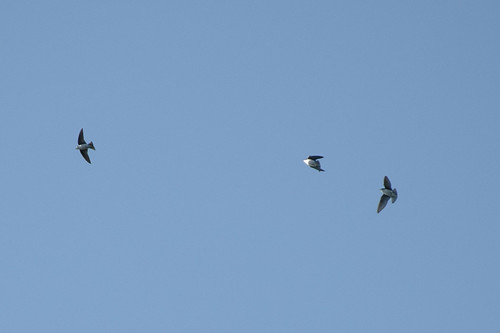The Black’s Nook Project has done its small part in confirming an eBird-NOAA prediction of early Tree Swallow migration this year by reporting six Tree Swallows on 3/18 at Black’s Nook and a pair again on 3/19. This happens to be three days earlier than the earliest previous first-arrival record for Fresh Pond in the eBird database (out of 70 March checklists from all years). The unusually warm winter in the eastern United States has led to an early movement of birds.
The common understanding of why Tree Swallows return to this region in March is that the benefits of securing early nesting sites outweigh the uncertainties of food supply and weather. March in New England is usually a pretty stressful time for these mainly insectivorous birds, after all. But the competition for cavity nesting sites near water is intense, and that limited supply of sites apparently rewards early staking of claims, despite the risks. The birds delay building nests until weeks later, but defend their sites in the meantime (Winkler et al, 2011; Sibley et al, 2001).
At least one swallow repeatedly approached the entrance to the nesting box marked #8 near the golf course, presumably checking it out on Sunday. Monday morning birds were again observed at the box.
We can’t prove from this evidence alone that the birds wouldn’t have stopped here anyway. But these observations, together with other things we know, suggest the importance for this species of managed spaces like Black’s Nook. These boxes are maintained by volunteers from the Friends of Fresh Pond Reservation. Elizabeth Wilde of the Friends arranged to have the boxes put up earlier than usual this year, literally the day before the first report, precisely because of the warm temperatures and predictions of early arrivals. A great example of bird data informing management practice. The boxes are used successfully every year. Ideally we will confirm nesting later in the season.
We can’t prove from this evidence alone that the birds wouldn’t have stopped here anyway. But these observations, together with other things we know, suggest the importance for this species of managed spaces like Black’s Nook. These boxes are maintained by volunteers from the Friends of Fresh Pond Reservation. Elizabeth Wilde of the Friends arranged to have the boxes put up earlier than usual this year, literally the day before the first report, precisely because of the warm temperatures and predictions of early arrivals. A great example of bird data informing management practice. The boxes are used successfully every year. Ideally we will confirm nesting later in the season.
The Friends of Fresh Pond have reports on their nesting box program since 2004. For more on Tree Swallow life history and conservation see the sources below and PRBO Conservation Science. And for an example of how eBird data is being used to study the timing of migrations in response to temperature (and climate change) see the eBird story on this just-published paper.


No comments:
Post a Comment